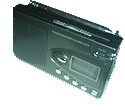|
First a little history: Do you remember a chap, about the 1890s, called Marconi? Although not the first to discover electromagnetic radiation, he was the one who managed to make the world aware it existed. He used, yip, you've guessed it, a spark generator. By creating a point at which energy is discharged at a sharp rate he managed to show that this energy would somehow magically appear at a point some distance away. Fair enough, he did have a few tuned circuits to assist, but the principle remains. Taking this a little further. With Fourier Analysis we can prove that all waveforms can be reconstructed by the correct addition of amplitudes and phases of selected harmonics of a base frequency. But what about the sharp rise or fall, such as when a flashover, arcing, or corona occurs. The faster the rise or fall time, the higher the number of harmonics are needed to create, or regenerate the wave shape. But we've been speaking of the regeneration of a waveshape, with a view to understanding it. In reality such a waveshape generates a number of harmonics, well into the radio frequency spectrum. You want proof? Take a portable long/medium wave radio, tuned to where there is no station (the signal of a station may block the effect being demonstrated) and go stand near a neon sign. You'll quickly hear what is being referred to (said with rather a lot of confidence as there is yet to be found a neon sign that does not arc over somewhere!). Although the principle of "the closer you are to the source, the louder will be the interference" does apply, there is one added feature of using a long/medium wave portable (as opposed a car radio); A portable is fitted with a ferrite antenna which is directive. The maximum signal is received at 90° to the antenna. The opposite is also true, almost no signal is received along the axis of the ferrite rod. It is in fact this latter property that is of most use when tracking the source of an interference as the drop-off in signal is very pronounced the moment the source is "facing down" the length of the ferrite rod. Tune into a station and turn the radio through 180° and the effect will be very noticable. Before searching for an interference it would be good practice to try this technique on the above mentioned neon sign, just to really get the feel of what it's going to be like. Have a bit of distance between you and the sign, e.g. try this across the street. Now, try a new trick. Walk a hundred or so paces down the street and do the radio rotation again (here's hoping there is only one neon sign giving interference!). What will be noticed is the point where the least signal is heard will always be when the radio is in line with the path from the sign to you. Just a word on the radio itself; The best type is one with an old-fashioned tuning dial as opposed to the more modern "digitally tuned". These modern types tend to 'hunt' to a station rather than allow tuning to a free space where no station exists (if you must get a digital type, then get one that allows "stepping through" the frequencies). Although the one shown above appears to be digital, the actual tuning is via an old fashioned dial with a digital frequency readout. Using the principle of being able to ascertain the direction of the source of the interference, by adding one simple step to the process, called triangulation, the source can be quickly determined using the angle taken at two seperate points. There is one other technique, although you could find yourself walking the wrong way, by turning the radio until you ascertain the direction fairly accurately, then turn the radio back 90°, and walk along the path listening to the volume of the signal until you "stumble" across the cause. Be warned, many have found themselves walking away from the source, not towards it. Not all interferences are permanent or conveniently located where they can be triangulated on, such as those that appear in a house. The internal wiring could lead you to where the spark is not being generated and one has to be aware of this. However, finding these is still one of the easiest things to do. Usually these disturbances happen when something is turned off and the spark causing a massive amount of noise on the network. Switch on the radio and tune to a place where there is no station. When the radio makes a crackle find out what turned off as the crackle happened (being in a house will allow relatively easy communication between the radio listener and those listening for signs of something coming to rest). Not all interferences can be traced in this way as it depends heavily on the rise or fall time of the offending pulse, as well as the effectiveness of any filtering on the mains supply. However, there are also many success stories where the only instrument that helped trace a fault was the portable radio.
© 09.06.01 |
 MEASUREMENT TECHNIQUES:
MEASUREMENT TECHNIQUES: Imagine the surprise, arriving on site, and pulling a long/medium wave radio out of the bag - for a power quality complaint!?
Imagine the surprise, arriving on site, and pulling a long/medium wave radio out of the bag - for a power quality complaint!?